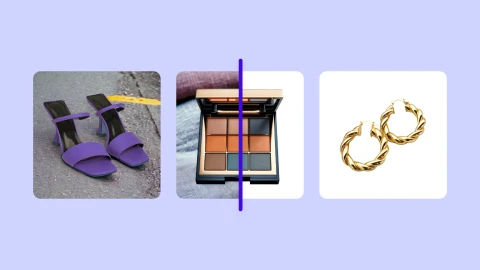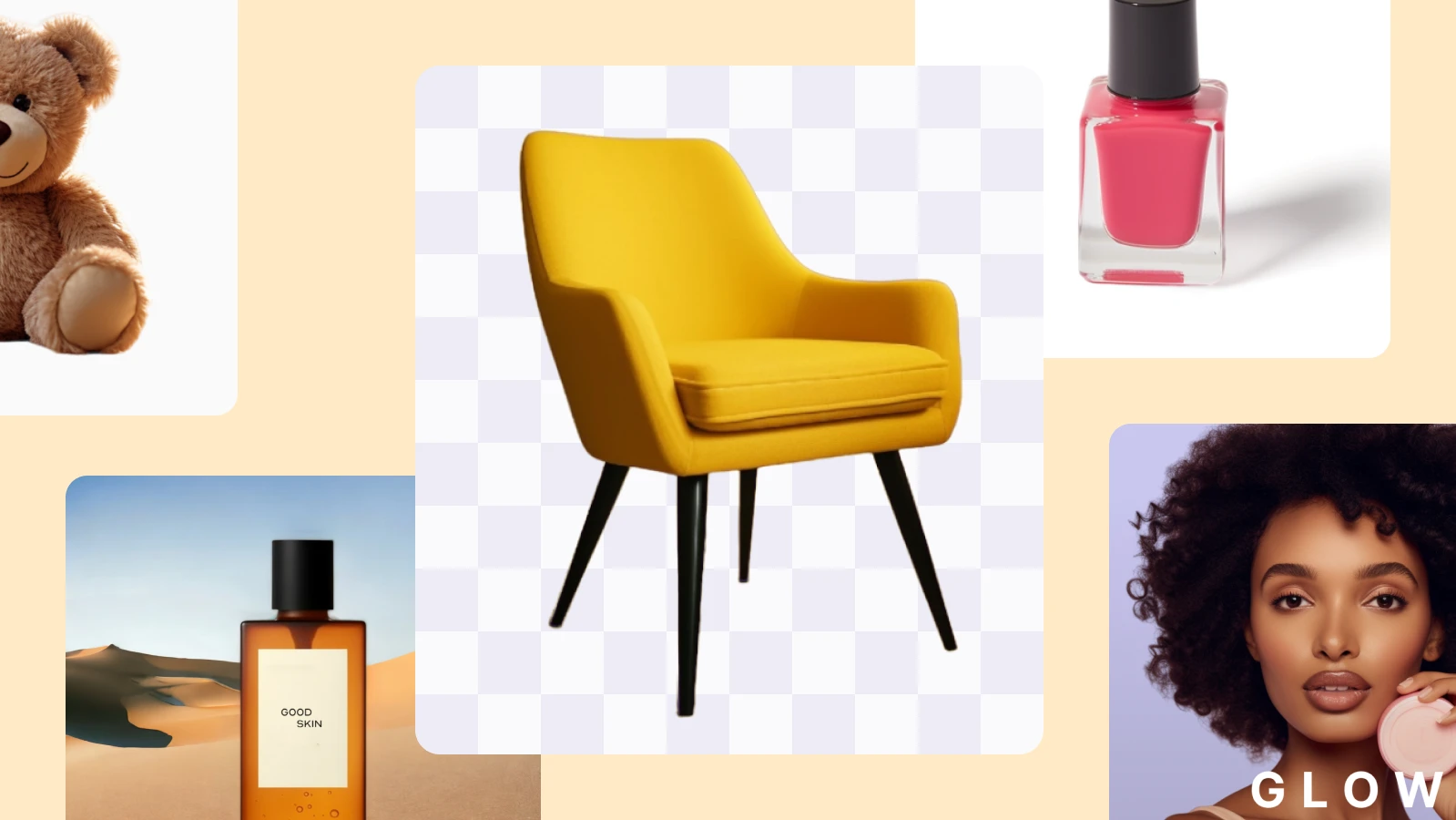10 product photography ideas for your e-commerce


Creating professional product photos doesn't require an expensive product photography setup. When your website is ready, but your product images don't reflect the quality of what you're selling, it's time to explore creative product photography ideas that work with what you already have.
This guide shares ten practical product photography ideas for e-commerce owners who need high-quality visuals without a high-end budget. Using just your smartphone, natural light, and everyday items from around your home, you can capture compelling product images that showcase your items' best features and tell your brand's story.
1. Create 360-degree product spins to show every angle
Your customers can't pick up and examine your products online like they would in a store. This missing experience often leads to hesitation during the purchasing process. 360-degree product photography solves this problem by giving shoppers the next best thing to holding the item themselves.
These interactive images allow customers to rotate products and view them from all angles, significantly reducing purchase anxiety. Studies show that interactive product images can increase conversion rates by up to 30% compared to static photos alone, especially for products where design details matter on all sides. Use this technique for items with various features or uses like electronics, furniture, fashion items, or the Stanley travel mug pictured below.
A lot of e-commerce marketplaces allow you to list multiple images so, to capture a full 360 view:
Take a picture of the top, sides, and bottom of the product
Select a background from Minimal Shop in Photoroom and add your pictures (it automatically cleans up the original background)
Add some realistic AI Shadows to give it depth. (I set the shadow to Long 2 in the mobile app for the images below)
 2. Stage lifestyle scenes to show your products in action
2. Stage lifestyle scenes to show your products in action
Lifestyle photography bridges the gap between the products you sell and the experience/result they provide by showing your items in their natural habitat, being used as intended. This approach taps into the emotional side of purchasing decisions. When customers see your product in a real-life context, they can envision how it fits into their own lives.
Lifestyle photos also communicate your brand's personality and target lifestyle, helping attract the right customers who identify with your brand's aesthetic and values. They have also been proven to perform better in ads.
Here's how to create effective lifestyle shots:
Choose settings where your product would naturally be used
Keep backgrounds clean and relevant to avoid distraction
Include models or hands interacting with the product if appropriate
Here is an example of a lifestyle shot for a flower vase generated with Photoroom. I used templates from the Interior section (Open Photoroom, type “Interior” in the search bar)

3. Capture extreme close-ups (macros) to highlight quality details
Extreme close-ups serve as your product's quality assurance, letting customers examine craftsmanship and materials just as they would in person. These details often justify the price point for premium or handcrafted products like jewelry or embroidery.
Showing things like detailed stitching on leather goods, the weave of a fabric, or the finish on jewelry creates confidence in the quality of your items. These are features that might go unnoticed in standard product shots but could be decisive selling points.
To capture effective macro shots:
Use your smartphone camera (Don’t change the zoom, just move the phone closer or farther from the item)
Focus on textures, materials, stitching, or unique features
Use a ring light to bring out details
Use Photoroom to enhance sharpness and contrast where needed
I enhanced this bracelet’s macro shot using Photoroom’s AI Upscale feature and increased the sharpness by 65.
 4. Use clean white backgrounds for professional appeal
4. Use clean white backgrounds for professional appeal
Most major marketplaces like Amazon and eBay actually require white background images for main product photos because they look professional and focus all attention on your product. This classic approach eliminates distractions and creates a consistent, polished look across your product catalog.
They help customers quickly identify product features and compare options when browsing your store. Beyond meeting marketplace requirements, white background photos are versatile building blocks for your marketing. They can be easily edited, placed into different contexts, or used in catalogs and print materials without clashing with other design elements.
Create this look easily:
Use a white poster board, curved up against a wall
Position your product at least 12 inches from the background
Tip: You can take your shot against any background, upload it to Photoroom, and replace the background with white in seconds

5. Use strategic props to tell your product's story
Props are decorative elements that provide context and enhance your product's appeal. Thoughtfully selected props create a narrative around your item that helps customers understand its purpose, scale, and lifestyle fit.
For example, a handcrafted soap photographed alongside natural botanical elements suggests purity and organic ingredients, while the same soap placed with luxury towels and marble surfaces positions it as a premium bathroom accessory.
If you don’t know how to pick a prop, you can ask ChatGPT to describe a prop set that complements your product or shares an aesthetic with your brand.
I used Photoroom’s AI Backgrounds to generate these props in the image below (AI Backgrounds >> Create a background). The prompts I used were:
A: “surrounded by two distinct botanical elements”
B: “placed on a marble bathroom counter top with flower petals next to luxury towels”

“I’m really skeptical when it comes to AI photography and photo editing because I am a photographer and I want things to look realistic, but it really does. I rarely ever get a background from Photoroom that’s like ok, you can tell this is not real. They all look so good and so realistic.” - Nick Hawkins, Founder, The 1994 Candle Co.
6. Create dramatic reflection photos for premium appeal
Reflection photography adds a sophisticated, high-end dimension to your product images. This technique creates the illusion of your product sitting on a glossy surface, adding depth and visual interest while instantly elevating perceived value.
The reflection also provides another perspective on your product, showing bottom details or alternative angles without requiring additional photos. This technique is particularly effective for jewelry, watches, cosmetics packaging, electronics, and any products with elegant or interesting shapes like perfume bottles.
To create reflection photography:
Place your product on a sheet of plexiglass, glass, or a glossy black/white surface
Position lighting at a 45-degree angle to control reflection intensity
Keep backgrounds simple to maintain focus on the product and its reflection
Or save yourself the stress and use Photoroom’s AI Water backgrounds:
Upload your image to Photoroom, select Backgrounds, search for Water
Generate and customize as many as you want

7. Use the ghost mannequin technique for apparel photos
The ghost mannequin technique (also called the "invisible mannequin" effect) solves one of the biggest challenges in clothing photography: showing garment structure and fit without the distraction of a visible mannequin or model.
This approach creates a 3D, hollow-form appearance that helps customers visualize how clothing items hang and fit while maintaining a clean, professional look. Unlike flat lay photography, ghost mannequin shots show important structural details like sleeves, collars, and how the garment drapes.
To create the ghost mannequin effect:
Take one photo of the garment on a body form (front/side/back)
Remove the mannequin using Photoroom's Erase tool
You can find the Erase tool by tapping on the image after you upload it. You’ll see the screen below, then rub your finger over the parts you want to remove.
📌 PRO TIP: Use the Assisted option to automatically detect objects and make your life easier!
8. Create boutique-style displays with countertop setups
Display countertop photography recreates the premium retail experience of a high-end boutique or specialty shop directly in your product images. This technique simulates how items would appear in a curated store environment, triggering the positive associations customers have with in-person shopping experiences. The elevated, intentional positioning signals quality and exclusivity, making this technique particularly effective for jewelry, confectioneries, gourmet foods, and leather goods like bags, belts, etc
To create effective countertop display photography:
Select appropriate surfaces that complement your products (marble, wood, glass, or textured fabric)
Position products at slight angles rather than perfectly parallel to create dynamic arrangements
Consider height variations using subtle risers or platforms covered in fabric
Keep backgrounds simple and uncluttered to maintain focus on the products
However, for this design example below, I didn’t have to do all that. I simply used a Photoroom template from the Cafes & Bakeries section, which already has a countertop, and added the cupcake in one tap. The background from the original image was automatically removed.

9. Arrange eye-catching flat lays with complementary items
Flat-lay photography is shooting items from directly above on a flat surface, and it has become a staple of modern e-commerce for good reason.
By carefully curating complementary items around your main product, you suggest a desirable lifestyle and help customers envision how your item fits into their world. This contextual marketing increases perceived value and helps customers understand the product's purpose and benefits.
Here's how to create stunning flat lays:
Choose a clean, simple background (white, pastel, or textured neutral works best)
Select complementary items that make sense with your product but don't overshadow it
Shoot in natural light from directly above
For this product photography idea, let’s pretend we have an online padel clothing and accessories shop. The image was created by neatly folding and organizing the products on the floor and taking a photo from above with an iPhone. The mint green background is one of the colors you can find in Photoroom’s Minimal Shop template.

10. Create editorial magazine-style shots for luxury positioning
Editorial photography elevates your products from simple merchandise by mimicking the sophisticated aesthetic of high-fashion magazines. This approach positions your items as trendsetting and aspirational rather than merely functional.
Unlike standard product photos, editorial shots tell a compelling visual story through creative composition, dramatic lighting, and artistic direction. This technique works exceptionally well for fashion accessories, beauty products, premium home goods, and any items where you want to create emotional appeal and luxury associations.
With Photoroom's AI Images feature, you can now generate professional editorial-style photos without expensive photo shoots, models, or specialized equipment. Here are the AI prompts I used for these images:
For the perfume bottle: "Elegant perfume bottle with gold accents catching dramatic side lighting against a dark marble surface, wispy smoke curling around the bottle, soft focus background, editorial magazine style photography" with Cinematic rendering style
For the red glasses example: "A photo shot of a woman wearing dark square glasses with red frames. She is in black and white but the glasses are in color mode, slightly dropped from her eyes" with Hyper-realistic rendering style

FAQs about product photography
How to take good product photos?
Use proper lighting (natural light is best), a clean background, and a steady hand or tripod. Focus on getting clear, sharp images that show the product accurately. Use your smartphone's portrait mode for professional-looking shots, and edit with apps like Photoroom to remove backgrounds, enhance colors, and fix imperfections.
What makes a great product photo?
A great product photo clearly shows the item's features with appropriate lighting that highlights textures and colors, proper scale reference, and images that show the product from multiple angles. The most effective product photos also communicate the product’s value, quality, and how it fits into the customer's life.
Can AI help create professional product photos?
Absolutely! AI tools like Photoroom's AI Images and AI Backgrounds can transform amateur photos into professional-looking images. These technologies can generate studio-quality images without expensive equipment.
How to capture unique product images?
Consider unexpected angles, creative lighting (like using colored gels or dramatic shadows), interesting props that tell a story, or unusual settings that make your product stand out. Experimenting with techniques like motion blur, macro photography, or reflection can also result in distinctive images that capture attention in crowded marketplaces.
What are the best product photography ideas?
The most effective product photography approaches depend on your specific products and brand positioning, but here are some top ideas:
360-degree product spins
Lifestyle scene staging
Extreme close-ups/macro photography
Strategic prop styling
Dramatic reflection photos
Ghost mannequin technique
Boutique display setups
Eye-catching flat lays
Editorial magazine-style photography















